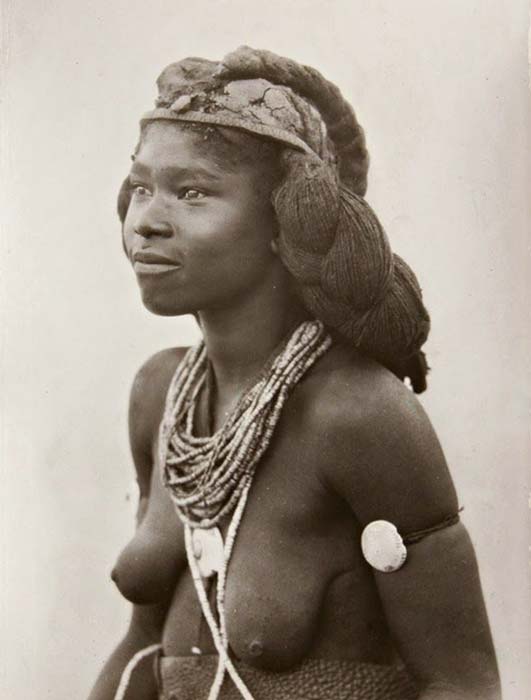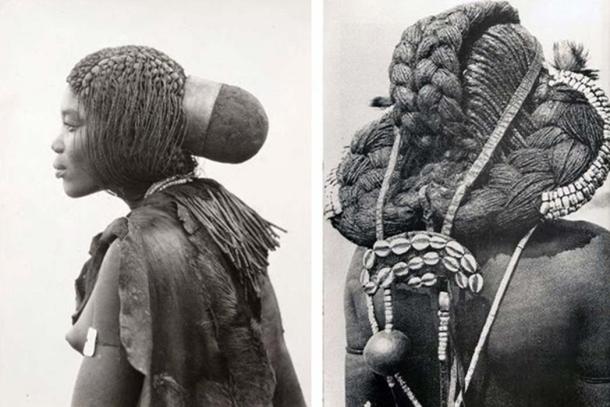The Braided Rapunzels of Namibia: Every Stage of Life is Reflected in Their Hair
Not everyone desires floor-length hair, but if you do, you can take some lessons from the Mbalantu women of Namibia in Africa, who are renowned for their incredibly long, braided hair.
Throughout the world, numerous ancient tribes exist that have retained their ancient traditions, which have been passed down from one generation to the next. The Mbalantu, which resides near the southern tips of Angola and nothern border of Namibia, did not participate in agreements signed between the German Government and various tribal chiefs in 1908, enabling them to retain their traditions and skills, which can still be seen today.

The Mbalantu reside near the Angola – Namibia border (Public Domain)
For the Mbalantu tribe, many of their traditions revolve around hair. As girls and women pass through various stages of life, ceremonies takes place in which their hair is prepared in particular ways to reflect their new status.
“The transformation from one status to the next is so crucial to the existence of the human being that the life span of an individual can be seen as formed of statuses following each other, which all have a similar beginning and end.” (Soiri, 1996).
- Legendary Locks: Can Hair Act as a Sixth Sense, Protecting us from Danger?
- 3,300-year-old Egyptian woman with hair extensions discovered in Armana
- Changing Beauty: The Use of Elaborate Wigs in Ancient Egypt
Mbalantu Girls Prepare For Their Headdress
One of the greatest honors for a Mbalantu tribeswomen is to reach the stage in their life when they are permitted to wear their hair as an elaborate headdress. Preparation for this stage begins around the age of twelve, when the hair undergoes special treatment to drastically speed up hair growth. First, they coat their hair in a thick paste made from the finely ground tree bark of the omutyuula tree mixed with fat. A few years later, this paste is loosened to make the hair visible. Fruit pips are then tied to the hair ends with sinew strings.
When girls reach the age of sixteen, long sinew strands that reach the ground are attached to the hair. In the same year they undergo the Ohango Initiation ceremony, a living tradition with roots in the ancient past. Before the ceremony begins, their hair is styled into four long, thick braids, known as eembuvi.
The young women “were always prepared for marriage by efundula or ohango, the initiation ceremony. The ritual had to be performed by girls in order to be accepted in the women’s category.” (Soiri, 1996)

The eembuvi-plaits of Mbalantu women before the Ohango initiation ceremony (1930s). Photo: CHL Hahn, Collection Antje Otto
An Elaborate Headdress for Marriage
Once the girls complete their initiation ceremony, they are considered to be women. To celebrate this new status, their hair undergoes yet another change. A new layer of the tree bark and oil mixture is applied to the hair to once again encourage growth. (The length of the hair is so important to Mbalantu women that some were even known to buy hair from other women to attach to their own.)
After the paste is applied, the long plaits were taken up and arranged into an elaborate headdress, signifying that the woman was married. “According to historical reports this headdress was a “mighty coiffure” and was so heavy that the upper ends were often attached to a piece of rope or skin, which was fastened around the forehead in order to distribute the load more evenly,” reports the Gondwana Collection. “The front edge of the coiffure known as omhatela was often decorated with a band of large, white beads (omawe gomupolo). At the back just below the omhatela a leather strip decorated with cowrie shells was also sometimes attached.”

A beautiful young woman of the Mbalantu tribe wears her hair as a headdress, signifying that she is married. Photo: CHL Hahn, Collection Antje Otto
This particular headdress was usually worn for several years after marriage. Throughout their lives they also changed the style of their headdress, often to reflect a new status, such as the birth of a child. For the women of Mbalantu, traditions around the arrangement of their hair was deeply imbued in every stage of life, from birth to puberty, marriage, child birth, and finally death.
- Osterby Man Still Has a Great Hairdo Nearly 2,000 Years On!
- The Australian Yowie: Mysterious Legends of a Tribe of Hairy People
- Herero and Namaqua Genocide: The little-known first genocide of the Second Reich

Different styles of headdress worn by the Mbalantu women. Photo: CHL Hahn, Collection Antje Otto
Top image: The eembuvi-plaits of Mbalantu women. Photo: CHL Hahn, Collection Antje Otto
References
The Mbalantu Women of Africa and Their Floor-Length Natural Hair Tradition (2015). Black Girl Long Hair. Available at: http://blackgirllonghair.com/2015/06/mbalantu-women-of-africa-and-their-floor-length-natural-hair-tradition/
Soiri, Iina (1996). The Radical Motherhood: Namibian Women’s Independence Struggle. Nordic Africa Institute.
The Eembuvi Plaits of the Women. Gondwana Collection. Available at: https://gondwanatravel.wordpress.com/tag/initiation-ceremony/




















Comments
Ye Gods! How the hell does one sleep with hair that elaborately arranged! I had enough issues with knee length hair done in a single braid sometimes.